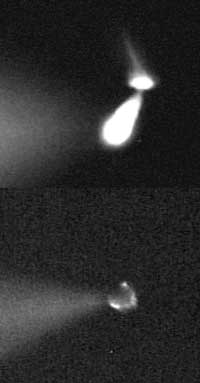Katie Rennie, PhD
Research Activities
Vestibular Hair Cell Lab
Summary of the Lab's Work
This laboratory's research is focused on hair cells of the vestibular system. The vestibular system of the inner ear senses accelerations of the head and interacts with other systems to produce the sensation of balance. It is estimated that more than one third of adults in the US experience vestibular dysfunction at some time in their life. However the mechanisms underlying normal and abnormal processing of vestibular sensory signals are not well understood. Our research aims to elucidate how signals are processed in the peripheral vestibular system using rodent models.
Mechanoreceptive hair cells in the vestibular periphery convert tiny mechanical displacements of the hair cell bundle into electrical signals which are transmitted by vestibular afferent nerves to the brain. Type I and type II hair cells are found in the vestibular systems of mammals, birds and reptiles. The two hair cell types differ in several respects including their innervation characteristics. Whereas bouton afferent nerve terminals make synaptic contact with a small portion of the type II hair cell basolateral membrane, calyx-shaped afferent terminals engulf the basolateral surface of one or more type I hair cells. In order to understand how signals are transformed from a mechanical stimulus at the type I hair cell bundle into electrical activity of calyx afferents we use electrophysiological (patch clamp), molecular and mathematical modeling approaches. We have identified several different types of potassium channels in vestibular cells and are currently assessing their modulation by candidate efferent transmitters and ototoxic drugs. It is hoped that results from these studies will clarify some of the mechanisms underlying vestibular disorders.
Research Focus
Synaptic transmission between type I hair cells and their calyx afferents is not well understood, but we have recently confirmed that "quantal" responses can be recorded from adult calyces supporting release of neurotransmitter (glutamate) from type I hair cells (Rennie and Streeter 2006). We are currently investigating synaptic transmission in type I hair cells and calyces during postnatal development. The rodent vestibular system is immature at birth and the membrane properties of semicircular canal type I hair cells change dramatically during the first few postnatal weeks (Li et al. 2010). We hypothesize that changes in synaptic efficacy also occur, since rotational responses of semicircular canal afferents and the vestibulo-ocular reflex reach maturity several weeks after birth.
Efferent fibers make synapses with type II hair cells and with calyx terminals surrounding type I hair cells. Stimulation of efferent fibers increases the firing rate of calyx afferents with slow and fast components, but the underlying receptor-mediated mechanisms are unknown. We are investigating the effects of the candidate efferent transmitters acetylcholine (ACh) and nitric oxide (NO) at the calyx synapse.
Mathematical models are being developed to address calyx physiological function. The combination of experimental and simulated approaches should provide important new information about how cellular mechanisms encode neural signals in the vestibular system.
Collaborators
Timothy Benke, MD, PhD, Departments of Neurology, Pediatrics, and Pharmacology
Ilkyeun Ra, PhD, Department of Computer Science and Engineering

Figure. Whole cell patch clamp recordings are verified by the inclusion of fluorescent dye (Lucifer Yellow) in the patch electrode solution. A fluorescently labeled type I vestibular hair cell is shown in the upper panel, a fluorescent calyx terminal surrounding a type I hair cell is shown below. In both images the out of focus patch electrode is shown to the left.